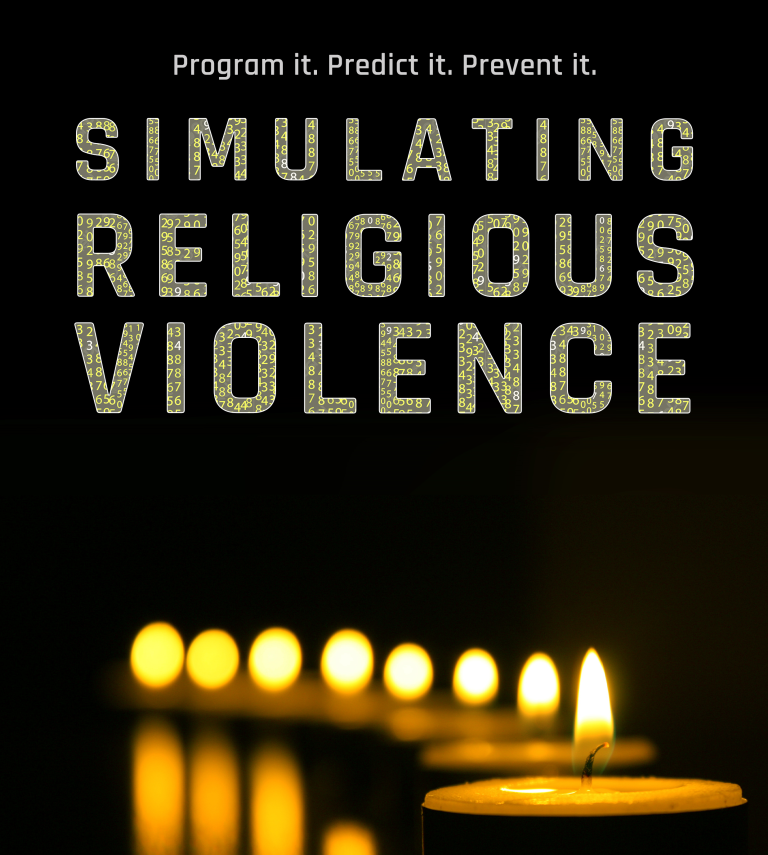This episode features an interview with Dr. Jenn Lindsay and Dr. Wesley Wildman on the forthcoming documentary film, ‘Simulating Religious Violence.’ This film explores a team of researchers seeking to build the kind of computational model that I just mentioned. Dr. Lindsay directed the film. She is Professor of Sociology and Communications at John Cabot University and the CEO and head of production at So Fare Films. Dr. Lindsay is an accomplished filmmaker, including the award winning documentary film, Quarantined Faith. Dr. Wildman is Professor of Philosophy, Theology, and Ethics, and of Computing and Data Sciences. He was one of the researchers involved in creating and deploying the simulation.
The film documents the Modelling Religion Project, which was a three year project made in collaboration between researchers at the Virginia Modeling and Simulation Center (VMASC), the Center for Modeling Social Systems at the University of Agder in Norway, and the Center for Mind and Culture, the home for the Digethix podcast. If you’d like to see the film, it will be premiering at Boston University on November 19th in the Faculty of Computing and Data Sciences Building on the 17th Floor. You can also see it at the American Academy of Religion Annual Meeting in San Diego on November 23rd, and in Rome on March 1st at John Cabot University in Rome.
Premiere event at BU 11/19: https://www.eventbrite.com/e/simulating-religious-violence-premiere-tickets-953785667607
Film website: https://www.sofarefilms.com/simulatingreligiousviolence
Project website: https://mindandculture.org/projects/past-projects/modeling-religion-project/
Credits:
Music: “Dreams” from Bensound.com
Episode art: Jenn Lindsay
Episode Transcript
Introduction
Seth Villegas: Computer simulation is on the cutting edge of leading research. But what is computer simulation? It’s not something like the virtual reality portrayed in the matrix. Instead, it is a sophisticated program designed to mimic a specific situation. Imagine for a second that you are a local mayor trying to make decisions about whether to add an additional lane on a busy road. You can gather data from the real world on the average number of drivers who use the road and how those drivers behave: do most of them turn onto smaller streets or do they continue forward? If we were to construct a sophisticated simulation, we could begin to model driver behavior and potential changes in driver behavior with the addition of another lane. We could even test out various options that the city is considering. Should they add in the lane in this part of the city or somewhere else? Why not input both options into the simulation and see which works better?
In academia today, computer simulation is a powerful tool to test out theories and to attempt to understand complex real world problems. For example, consider that you were looking to understand the Gurjarat riots in India, which left over a thousand people dead, the Irish Troubles, with tens of thousands of casualties over the course of four decades, and the Boston marathon bombing, which took place just down the street from my home here at Boston University. What if you could build a computational model to understand the circumstances that lead to each of these events? What if you could then use that model to look for those same circumstances where violence is next most likely to break out?
Today, I will be interviewing Dr. Jenn Lindsay and Dr. Wesley Wildman on the forthcoming documentary film, ‘Simulating Religious Violence.’ This film explores a team of researchers seeking to build the kind of computational model that I just mentioned. Dr. Lindsay directed the film. She is Professor of Sociology and Communications at John Cabot University and the CEO and head of production at So Fare Films. Dr. Lindsay is an accomplished filmmaker, including the award winning documentary film, Quarantined Faith. Dr. Wildman is Professor of Philosophy, Theology, and Ethics, and of Computing and Data Sciences. He was one of the researchers involved in creating and deploying the simulation.
The film documents the Modelling Religion Project, which was a three year project made in collaboration between researchers at the Virginia Modeling and Simulation Center (VMASC), the Center for Modeling Social Systems at the University of Agder in Norway, and the Center for Mind and Culture, the home for the Digethix podcast. If you’d like to see the film, it will be premiering at Boston University on November 19th in the Faculty of Computing and Data Sciences Building on the 17th Floor. You can also see it at the American Academy of Religion Annual Meeting in San Diego on November 23rd, and in Rome on March 1st at John Cabot University in Rome.
This interview will cover what you will see in the documentary, the kinds of questions that it both raises and answers, and the research behind it. I hope that this conversation can spur your interest and I hope to see you in person at one of the two upcoming premieres! Now, I present to you, Dr. Jenn Lindsay and Dr. Wesley Wildman.
Conversation
Seth Villegas: Please tell us about the Simulating Religious Violence film.
Conclusion
Seth Villegas: I hope that this interview was able to answer some of your questions and to explain the basics of computational simulation. If you have some questions and would like to meet Dr. Lindsay, Dr. Wildman, or some of the other researchers shown in the documentary, you should definitely consider coming to one of the upcoming premieres on November 19th here at BU, November 23rd in San Diego, and March 1st in Rome. The film also furthers to show things that we are only able to discuss in passing here.
If you’d like to respond to this conversation computational simulation, you can email us digethix@mindandculture.org. You can find more information about DigEthix at digethix.org. You can find us on Facebook and twitter, @digethix, and on Instagram, @digethix future. The intro and outro song dreams was composed by Benjamin Tissot. Thank you for listening. I hope to see you at one of our upcoming premieres.


